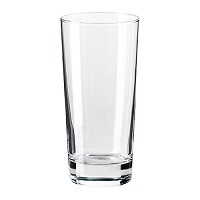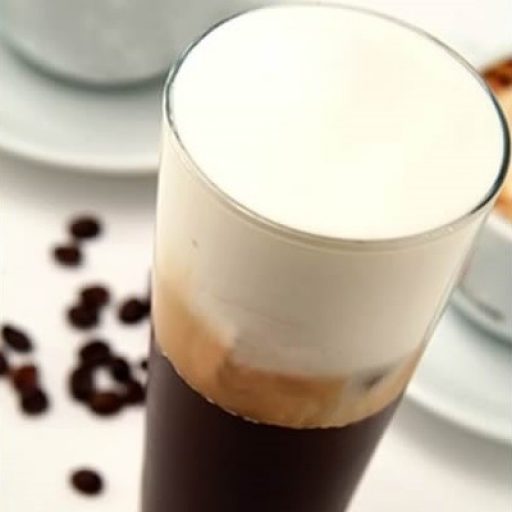So you went for vacations in Greece or Cyprus or southern Italy and liked the cold coffee they serve there? Or maybe you have a Greek colleague who’s busting your balls non stop about how great cold coffee is, and just want him to shut up? You’re at the right place!

These recipe is for both espresso freddo and cappuccino freddo which are exactly the same thing; you just add cold foam milk on top of the espresso freddo to make the cappuccino version.
Over the years I’ve tried to simplify the recipe a bit. It’s not barista-level good, but anyone who’s tried it tells me it’s pretty decent.
You can see the video here:
To begin with, here’s the equipment you need:
- A strong coffee mixer. This is an absolute must, you can’t do without it. Outside of Greece they are called “drink mixers” (you can find them in amazon.de for example). They look like this:

- One or more suitable tall glasses. You need them to be around 200-250 ml for espresso freddo and 300-350 ml for cappuccino freddo. The ones from IKEA are fine.

- Two cocktail shakers, one for the milk and one for the coffee. It’s ok if you don’t have shakers though, you can just use normal glasses. But you can also buy them from amazon.de.

Now let’s see the stuff you need to prepare every time before you make cold coffee.
- I’m sure you’ll be surprised to learn that you need coffee! Basically you need a double espresso, around 100ml. What I usually do is use the Lungo capsules for my Dolce Gusto machine, and set it to 3 lines instead of 4.
- You also need straws, medium or thin ones. Don’t get the thick ones, they’re good for smoothies but not cold coffee.
- You need ice cubes. For every coffee, you need 5-6.
- If you’re going to make cappuccino (not espresso) freddo, you need milk, and you need it cold. Let me say that again, because it’s really really important: COLD. Ideally it should be 2 degrees. That means that you need to put it at the back of the fridge, not at the door where it’s a bit warmer. I usually put it in the refrigerator about 10min before I start. Keep it in the fridge until the moment you actually need it.
You also need to experiment a bit with the kind of milk you’ll use. I’ve found that the best one -at least from the ones you find in a regular supermarket- is full fat UHT milk, 3.5%. The one you get at the fridge of the supermarket isn’t as good –no idea why. If you find a “barista milk” get it; they have more proteins so they froth better.
- One of the shakers, the one to use for milk, has to be really, really cold. Put it in the refrigerator for at least an hour before making the coffee.
The basic idea is that, in order to make the foam milk, the milk has to be cold and stay cold. That’s why you need its container to also be frozen.
Now that we’ve prepared everything, let’s get to work.
- The first thing you need to do is prepare the coffee. If you also want sugar, you need to add it immediately afterwards, while the coffee is still hot, and stir it a bit with the mixer; that way it will melt nicely and you won’t get the awful crunchy feeling of unmelted sugar.
- Now we need to get our coffee ice cold. Put 5 or 6 ice cubes in the shaker or glass. Pour the coffee swiftly over the ice cubes. Stir it a bit with the mixer, but too much, you don’t want it to turn into foam. 5-6 seconds should be enough. Then pour everything (coffee+ice cubes) in the glass.
- If you want an espresso freddo, you can add a straw and stop here, you’re done. Otherwise you have one more step to prepare the cold foam milk.
- Get the milk and the 2nd shaker (or glass) out of the fridge. Fill the shaker just below half full. Stir it with the mixer for some time (at least 30 sec, can be more) until the surface is smooth and free of bubbles. This part is exactly why the shaker has to be cold. If it’s not, it will warm up the milk and it will be impossible to turn into foam.
Pro (well, sort of) tip: when holding the shaker with the milk and stirring, try to grab it from the top, not the middle or the bottom. That way the heat from your hand will affect the milk as little as possible.
The result should, ideally, look like this:
The water -always with ice cubes!- is mandatory. The beach isn’t, but it’s a very nice addition 😉


Για σας παιδιά!
I definitely agree with the UHT milk, until I tried this, I had very disappointing results with fresh milk (it just doesn’t work!)
Καλημέρα!
I’m preparing a new post (and video) focusing on foam milk. In short, what I’ve found from, well, countless tries and retries, is the following:
– The more protein the milk has the better. The one I use in Switzerland is one from Denner (protein 7g/100ml!). But anything that has at least 3.5g/100ml works, and this is quite easy to find in any grocery shop. Just read the “nutrition info” label.
– Fat doesn’t make a difference -except for taste of course. I usually go with semi-skimmed 1.5% milk, but as long as protein is ok, you can go with 0%, full fat 3.5%, whatever.
– The milk really has to be cold, if it goes above 6-7C it doesn’t work. So I keep it at the back of the fridge at 3-4C and take it out only when I need to prepare the foam milk.
– But -and this surprised me when I found out- the most important factor to generate a good foam milk, is the level of milk in the shaker cup. This is really really crucial! You have to have, give or take, enough milk so that when you start shaking it reaches the level of the agitator but NOT much more than that. If it’s less than that it comes out unstable and bubbly, it’s more than that then it fails to take in air when mixing and basically stays liquid, a kind of thick milk.